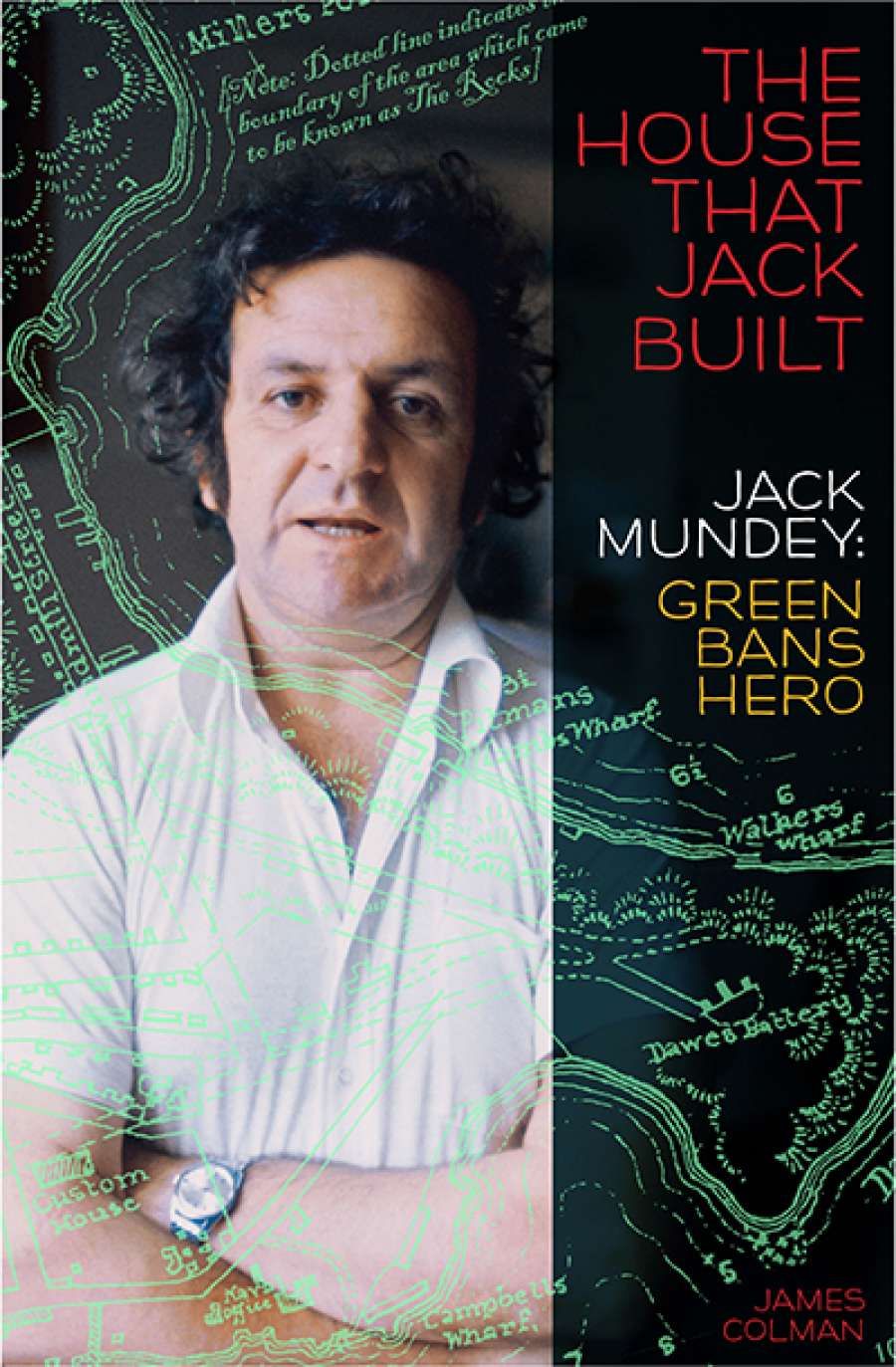
- Free Article: No
- Contents Category: Biography
- Custom Article Title: Dennis Altman reviews 'The House that Jack Built: Jack Mundey, Green Bans hero' by James Colman
- Custom Highlight Text:
The term 'green ban', first used in 1973, is so much part of our political vocabulary that we forget it has a specific and Australian genesis, which had considerable influence on the Greens ...
- Book 1 Title: The House That Jack Built
- Book 1 Subtitle: Jack Mundey, Green Bans hero
- Book 1 Biblio: NewSouth $49.99 pb, 376 pp, 9781742235011
Colman devotes one paragraph to the Nielsen affair, and passes quickly over the dramatic politics of Victoria Street and Mundey's connection with members of the 'Sydney Push'. By then Mundey had voluntarily stood down from his position in the union, and in 1974 the BLF was deregistered, following a concerted campaign by the Master Builders Association. Having been forced from the industry by internal battles for union control, Mundey moved on to a number of key positions in environmental groups, notably the Australian Conservation Foundation. Green bans quietly became less important in blocking developments, although some of the passion of that time lives on in protests such as the current moves against WestConnex in Sydney.
That unions might act to further larger social causes has a long and distinguished history in Australia, as in the refusal of the Waterside Workers to load Dutch ships involved in the fight against Indonesian independence after World War II. In many cases, union activism was closely linked to control by the Communist Party. Jack Mundey was a member of that party from the mid-1950s, though by 1984 he was elected as an independent to the Sydney City Council. I mention this not to 'red-bait' but because the positive role of the Communist Party in developing a whole set of progressive policies in Australia needs to be acknowledged. Colman's book barely discusses Mundey's role in the party, but it is relevant to understanding the way in which Mundey came to link the immediate aims of the union for better pay and conditions, to an analysis of the importance of preservation of both the natural and the built environment.
The green bans movement was part of a much larger story, and the strength of Colman's book is in placing it within the context of a new awareness of conservation spreading across the Western world from the end of the 1960s. As an architect and town planner, he is at home with the development of new approaches to planning. The House that Jack Built often moves beyond the house into the surrounding environment in which a plethora of forces were seeking to limit uncontrolled urban development.
 Jack Mundey (photograph by Rennie Ellis, National Library of Australia)Here one wishes Colman's editor had wielded a tougher blue pencil; parts of the book read like a series of encyclopedic entries which draw us away from any sense of Mundey or the immediate movement he created. At times Colman seems not to see the wood for the trees, indeed not to see the tree for the twigs. Too often the book becomes a resource to be consulted for specific information rather than a story that justifies the claim for Mundey's role as 'the anchor' of Australia's heritage movement. Thus Mundey barely emerges as other than the subject of hagiography; there are barely any references to his personal life, although much of this has been the subject of public discussion. There is no account of Mundey's political movement from the Communist to the Greens Party, or any analysis of the ruling by the NSW Industrial Court when it deregistered the BLF that 'the union had resorted to intimidation of employers and employees on a wholescale basis'.
Jack Mundey (photograph by Rennie Ellis, National Library of Australia)Here one wishes Colman's editor had wielded a tougher blue pencil; parts of the book read like a series of encyclopedic entries which draw us away from any sense of Mundey or the immediate movement he created. At times Colman seems not to see the wood for the trees, indeed not to see the tree for the twigs. Too often the book becomes a resource to be consulted for specific information rather than a story that justifies the claim for Mundey's role as 'the anchor' of Australia's heritage movement. Thus Mundey barely emerges as other than the subject of hagiography; there are barely any references to his personal life, although much of this has been the subject of public discussion. There is no account of Mundey's political movement from the Communist to the Greens Party, or any analysis of the ruling by the NSW Industrial Court when it deregistered the BLF that 'the union had resorted to intimidation of employers and employees on a wholescale basis'.
For a detailed account of the politics of the BLF in this period we need rely, as does Colman, on Meredith and Verity Burgman's book Green Bans, Red Union (1998). Given that the current government is now proposing legislation to correct what they allege are similar practices in today's building unions, it is disappointing that the subject is so lightly covered. Too often one feels the author felt Mundey looking over his shoulder and silencing any critical examination of the internal politics of the union at the time. Jack Mundey, who in the 1970s was excoriated by the media and conservative politicians for his role in green bans, has now become a certified 'national treasure', with honorary degrees from several universities and honorary life memberships of several mainstream conservation societies. Colman is assiduous in recounting his achievements, but his picture of Mundey is disappointingly one-dimensional.


Comments powered by CComment